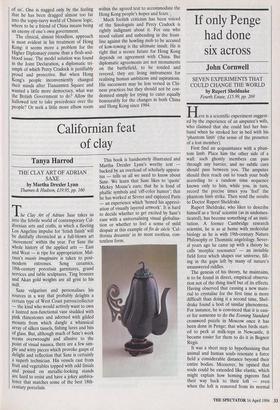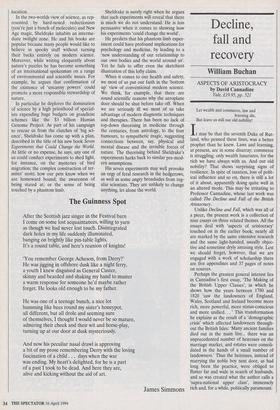If only Penge had done six across
John Cornwell
SEVEN EXPERIMENTS THAT COULD CHANGE THE WORLD by Rupert Sheldnake Fourth Estate, £15.99, pp. 269 Here is a scientific experiment suggest- ed by the experience of an amputee's wife, who claimed that she could feel her hus- band when he stroked her in bed with his `phantom limb' (the sense of the presence of a lost member).
First find an acquaintance with a phan- tom limb. Place him the other side of a wall: such ghostly members can pass through any barrier, and no subtle cues should pass between you. The amputee should then reach out to touch your body according to a random time sequence known only to him, while you, in turn, record the precise times you 'feel' the phantom limb strike. Then send the results to Doctor Rupert Sheldrake.
Rupert Sheldrake, who likes to describe himself as a 'feral' scientist (as in undomes- ticated), has become something of an insti- tution. A former Cambridge research scientist, he is as at home with molecular biology as he is with 19th-century Nature Philosophy or Thomistic angelology. Sever- al years ago he came up with a theory he calls `morphic resonance' — an invisible field force which shapes our universe, fill- ing in the gaps left by many of nature's unanswered riddles.
The genesis of his theory, he maintains, is to be found in direct, empirical observa- tion not of the thing itself but of its effects. Having observed that causing a new mate- rial to crystalise for the first time is more difficult than doing it a second time, Shel- drake found a host of similar phenomena. For instance, he is convinced that it is easi- er for someone to do the Evening Standard crossword puzzle in Moscow once it has been done in Penge; that when birds start- ed to peck at milk-tops in Newcastle, it became easier for them to do it in Bognor Regis.
It was a short step to hypothesising that animal and human souls- resonate a force field a considerable distance beyond their entire bodies. Moreover, he opined that souls could be extended like elastic, which might explain how homing pigeons find their way back to their loft — even when the loft is removed from its normal location.
In the two-worlds view of science, as rep- resented by hard-nosed reductionism (you're just a bunch of molecules) and New Age magic, Sheldrake inhabits an interme- diate twilight zone. He and his books are popular because many people would like to believe in spooky stuff without turning their backs entirely on modem science. Moreover, while writing eloquently about nature's puzzles he has become something of an international spokesman on a range of environmental and scientific issues. For example, he argues that confirmation of the existence of 'uncanny powers' could promote a more responsible stewardship of nature.
In particular he deplores the domination of science by a high priesthood of special- ists expending huge budgets on grandiose schemes like the $3 billion Human Genome Project. As part of his campaign to rescue us from the clutches of 'big sci- ence', Sheldrake has come up with a plan, described in the title of his new book Seven Experiments that Could Change the World. At little or no expense, he says, any one of us could conduct experiments to shed light, for instance, on the mysteries of bird migration; the complex construction of ter- mites' nests; how our pets know when we are homeward bound; the awareness of being stared at; or the sense of being touched by a phantom limb. Sheldrake is surely right when he argues that such experiments will reveal that there is much we do not understand. He is less persuasive when it comes to showing how his experiments 'could change the world'.
He predicts that his phantom limb exper- iment could have profound implications for psychology and medicine, by leading to a `new understanding of our relationship to our own bodies and the world around us'. Yet he fails to offer even the sketchiest illustration of this lofty claim.
When it comes to our health and safety, we most of us put our faith in the `bottom up' view of conventional modern science. We think, for example, that there are sound scientific reasons why the aeroplane door should be shut before take off. When we are seriously ill we most of us take advantage of modem diagnostic techniques and therapies. There has been no lack of top-down theorising in medicine through the centuries, from astrology, to the four humours, to sympathetic magic, suggesting connections between, say, physical and mental disease and the invisible forces of nature. The theorising behind Sheldrake's experiments harks back to similar pre-mod- ern assumptions.
His seven experiments may well provoke an orgy of feral research in the hedgerows, as well as some angry broadsides from reg- ular scientists. They are unlikely to change anything, let alone the world.



























































 Previous page
Previous page